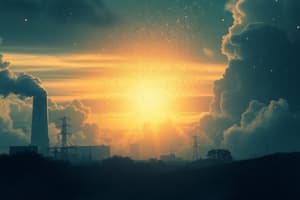Podcast
Questions and Answers
What are 'Persistent Organic Pollutants'?
What are 'Persistent Organic Pollutants'?
- Substances that significantly deplete the ozone layer (correct)
- Substances found in the atmosphere other than oxygen
- Medical waste that could transmit infectious disease
- Gases that induce global warming
What is the definition of 'Ambient air quality'?
What is the definition of 'Ambient air quality'?
- The concentration of air
- A geographical based instrument for planners
- General amount of pollution (correct)
- Any alteration of the atmosphere
What is a 'Stationary source' in the context of air pollution?
What is a 'Stationary source' in the context of air pollution?
- A certificate issued for vehicles
- Any vehicle propelled by or through combustion
- A standard for emissions of air pollutants
- A facility which emits or may emit any air pollutant (correct)
What is the 'Octane Rating/Anti knock index' related to?
What is the 'Octane Rating/Anti knock index' related to?
What are 'Hazardous substances' in the context of air pollution?
What are 'Hazardous substances' in the context of air pollution?
What is the definition of 'Emission' in the context of air pollution?
What is the definition of 'Emission' in the context of air pollution?
What are 'Greenhouse gases' and their role in environmental impact?
What are 'Greenhouse gases' and their role in environmental impact?
What is the significance of 'Ozone Depleting Substances'?
What is the significance of 'Ozone Depleting Substances'?
What is the purpose of a 'Pollution control device'?
What is the purpose of a 'Pollution control device'?
What is meant by 'Mobile Source' in the context of air pollution?
What is meant by 'Mobile Source' in the context of air pollution?
Flashcards are hidden until you start studying
Study Notes
Persistent Organic Pollutants
- Organic chemicals resistant to environmental degradation, remaining intact in the environment for long periods.
- Contain carbon and may include chlorine, leading to potential bioaccumulation in the food chain.
- Common examples include DDT, PCBs, and dioxins, which can have harmful effects on human health and ecosystems.
Ambient Air Quality
- Refers to the condition or cleanliness of the air surrounding us, typically measured in urban or rural areas.
- Evaluated based on concentrations of pollutants like particulate matter, nitrogen dioxide, sulfur dioxide, and ozone.
- A crucial factor for assessing public health risks and environmental policies.
Stationary Source
- Fixed emissions sources that do not move, such as power plants, factories, and refineries.
- Contribute to air pollution through the release of harmful substances including particulates, gases, and volatile organic compounds.
- Regulated through specific emission standards to control air quality and protect public health.
Octane Rating/Anti Knock Index
- Measures a fuel's ability to resist knocking or pinging during combustion, crucial for engine performance.
- Higher octane ratings prevent engine knocking, enabling higher compression ratios, leading to better efficiency and power.
- Commonly used in gasoline, with standard ratings ranging from 87 (regular) to over 100 (premium).
Hazardous Substances
- Pollutants deemed dangerous due to their potential to cause health issues or environmental damage.
- Include heavy metals, certain solvents, pesticides, and various toxic byproducts from industrial processes.
- Subject to regulatory controls due to their harmful effects on human health and the environment.
Emission
- The act of releasing pollutants into the air from various sources, impacting air quality and contributing to pollution.
- Can involve gases, liquids, or solid particles, influenced by human activities like transportation, industrial processes, and agriculture.
- Assessing emissions is critical for regulatory measures and environmental management.
Greenhouse Gases
- Gases that trap heat in the atmosphere, contributing to the greenhouse effect, and influencing global climate change.
- Major types include carbon dioxide (CO2), methane (CH4), nitrous oxide (N2O), and fluorinated gases.
- Their accumulation leads to rising temperatures, extreme weather events, and ecological disruptions.
Ozone Depleting Substances
- Chemicals responsible for the depletion of the ozone layer, allowing increased ultraviolet radiation to reach the Earth's surface.
- Notable examples include chlorofluorocarbons (CFCs) and halons, widely used in refrigeration and aerosol propellants.
- International efforts, like the Montreal Protocol, aim to phase out these substances to protect the ozone layer.
Pollution Control Device
- Equipment designed to reduce or eliminate the emission of pollutants from sources.
- Types include scrubbers, filters, catalytic converters, and electrostatic precipitators, targeting specific pollutants.
- Essential for complying with environmental regulations and improving air quality.
Mobile Source
- A moving source of pollution, including vehicles, aircraft, ships, and non-road engines.
- Contributes significantly to air pollution, particularly in urban areas, through emissions of hydrocarbons, carbon monoxide, and nitrogen oxides.
- Managed through regulations like emissions standards and technological advancements aimed at reducing their impact on air quality.
Studying That Suits You
Use AI to generate personalized quizzes and flashcards to suit your learning preferences.




